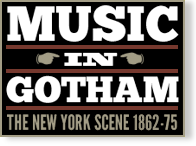Aim�e Opera Bouffe: Princesse de Tr�bizonde
Event Information
Venue(s):
Lyceum Theatre
Manager / Director:
Carlo A. Chizzola
Maurice Grau
Conductor(s):
Charles [conductor] Van Ghel
Price: $1; $.50 family circle; $2 reserved balcony & orchestra stalls
Event Type:
Opera
Record Information
Status:
Published
Last Updated:
10 June 2025
Performance Date(s) and Time(s)
21 Sep 1874, 8:00 PM22 Sep 1874, 8:00 PM
23 Sep 1874, 8:00 PM
24 Sep 1874, 8:00 PM
25 Sep 1874, 8:00 PM
26 Sep 1874, 1:30 PM
26 Sep 1874, 8:00 PM
Performers and/or Works Performed
Citations
“This charming opera, probably one of the most enjoyable of the prolific Offenbach’s works, has entered upon a career of success at the Lyceum fully equal to that which attended the production of ‘La Grande Duchesse’ and ‘Genevieve de Brabant.’ The sparkling nature of the play itself, leaving the music out of the question, with such admirable interpreters as Mlles. Aimée, Minelly, Gandon and Kid, and MM. Debouchet, Dupian and Debeer, is quite an attraction. When around it are woven some of the most seductive strains of the Franco-German composer, lyric champagne, as it were, it can be readily understood why ‘La Princesse’ should have become such a sterling favorite. The house was not crowded last night, and although the cast has not been changed since the first representation, the efforts of the artists have succeeded in introducing new features of interest, particularly in the scintillating dialogue and dashing music, and encores were more numerous than may be generally found on the opéra bouffe boards…in view of the success of the new Offenbachian opera there is little likelihood of a change for many nights to come.”
“The melodious and highly-amusing version of the story of Rhotomago’s spouse, for which Offenbach, and Nuitter and Trefeu are responsible, attracts large audiences to the Lyceum Theatre every night. The piece is admirably well adapted to the Aimée company. The vivacious ‘queen of opera-bouffe’ (as the advertisement calls her) presents a delightful bit of foolery as Raphael, and sings the three or four pretty numbers allotted to the part with charming grace. The simple little melody sung at Raphael’s first entrance—‘The Turtle Doves’—and his first number in the third act, ‘Flower that fadeth ere it blooms,’ are very pretty, and receive the amount of approbation usually bestowed on ballads of a similar character; but in the two extravagant numbers, the toothache song, and the highly-elaborate description of the waxen Princess who can say ‘Pappa!’ and ‘Mamma,’ Aimée excels. These two songs are both written in Offenbach’s best vein, and are more in the spirit of opera-bouffe than some other numbers in ‘The Princess of Trebizonde.’ The melody of ‘The Hunters’ Chorus’ in the second act is striking and pleasant, and will undoubtedly be favored by the agreeable boy who whistles. The two choruses of pages are also very pretty. Two characteristic songs of Prince Casimir—to one of which we referred some time ago—are among the best things in the piece. Duplan, who assumes this character, would not achieve a great reputation as a singer off the French opera-bouffe stage. But he is a capital actor, and his manner of rendering the two songs mentioned, especially the refrain with reference to Canada, the colonies, the Canaries, et cetera, is irresistible
‘The Princess of Trebizonde’ is a melodious and praiseworthy work. It is not so brilliant as ‘The Grand Duchess’ or as ‘The Daughter of Madame Angot’ (which by the way will soon be sung at the Lyceum Theatre), but with the exception of these two pieces it is the best opera-bouffe that has yet been produced in New York. Its story is clean, and the consequence is that the Lyceum Theatre is becoming a favorite resort for ladies.
We have already praised the acting of the piece on its first night. The impersonations by Dubouchet (who is one of the best ‘old men’ actors we have ever seen), Gandon and Kid, Debeer and Duplan, Minelly and Aimée, were all commendable then, and they have since been improved.”

